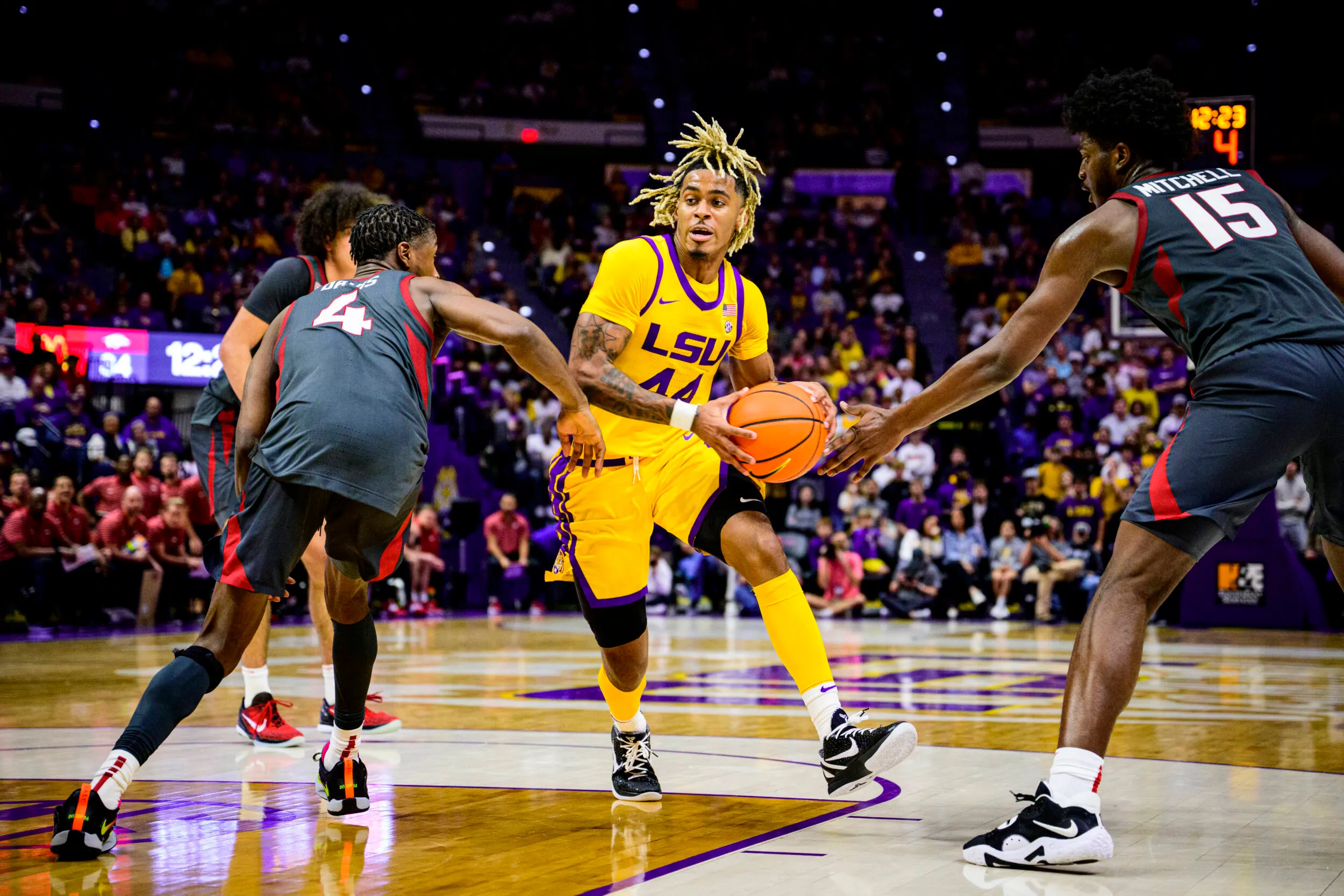Now hopefully back on the right track after a win over Ole Miss, the Razorbacks are back at home Tuesday to take on LSU. The Tigers knocked off the Hogs 60-57 in Baton Rouge on December 28th.
Meet the Tigers
We’ve already met Matt McMahon and LSU once, and at the time of that game, the Tigers were riding high. They broke into the top 25 around New Year’s after beating Arkansas to move to 12-1 (1-0 SEC).
Since then, things have not gone well.

So LSU hasn’t won since that game, and their last five losses have been by double digits. This is the LSU we expected to see before the season. Their record concealed a lot of their weaknesses as they were unimpressive against the likes of Arkansas State, Wofford, UT Arlington, NC Central, Winthrop, and East Tennessee State… but won all of those games anyway. Then the Hogs laid an egg in Baton Rouge. And then reality hit.

Model pick: Arkansas 76, LSU 64. The Hogs haven’t been great since that first matchup, but LSU has been worse. The Tigers are 361st out of 363 teams in Momentum, which just measures the difference between your average game grade in the last six games versus the whole season.
Scouting Report
LSU isn’t elite at anything on either side of the ball, but they aren’t just horrible at many things either. They will slow the pace down on offense and try to win a halfcourt game, where they’ll space you out and run through their star big man to get around the rim.
Defensively, they are already a heavy zone team, so expect almost exclusive zone against the Hogs. They will prevent shots around the rim in exchange for surrendering plenty of open 3-pointers. They won’t help Arkansas out much: for a zone team, they are actually decent at defensive rebounding, and they also do not foul much. Arkansas is probably going to have to actually make open jump shots.
Starters
LSU
- KJ Williams, PF, 6’10 (+8.6 BPM, 85 RAPM)
- Derek Fountain, PF, 6’10 (+2.8 BPM, 99 RAPM)
- Adam Miller, SG, 6’3 (-2.1 BPM, 57 RAPM)
- Trae Hannibal, SG, 6’2 (+1.0 BPM, 33 RAPM)
- Justice Hill, PG, 6’0 (-1.6 BPM, 51 RAPM)
Arkansas
- Makhi Mitchell, PF, 6’9 (+9.0 BPM, 64 RAPM)
- Jordan Walsh, SF, 6’7 (+2.4 BPM, 99 RAPM)
- Ricky Council IV, CG, 6’6 (+4.4 BPM, 97 RAPM)
- Devo Davis, SG, 6’4 (+0.5 BPM, 94 RAPM)
- Anthony Black, PG, 6’7 (+4.3 BPM, 100 RAPM)
With LSU, it’s all about Williams. He has a team-high 27% usage when he’s on the floor and leads the team with an 87 ORAPM. He’s comfortable handling the ball out on the perimeter, allowing LSU to give 5-out looks and create paths to the rim for their guards:
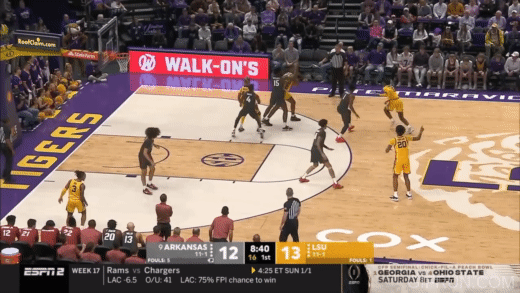
He’ll take about one-third of his shots from beyond the arc and he shoots an excellent 44% from out there. As a scorer, he’s very finesse, with a free throw usage of just 11% (that’s lower than Joseph Pinion or Devo Davis). While he doesn’t seek much contact, he shows nice touch around the rim:
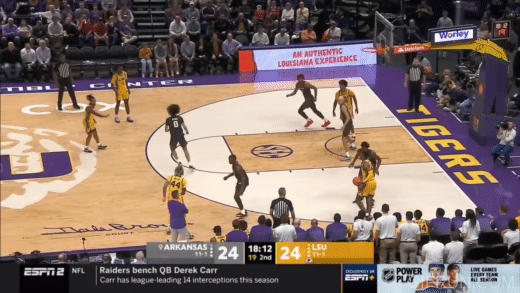
Other than getting to the line, he does everything else well: team-best 59% EFG, team-best 12% turnover rate, solid 10% offensive rebound rate.
After Williams, LSU’s offensive options are pretty limited. In recent games, they’ve gone to mostly-backup Cam Hayes, a 6’2 transfer guard from NC State who is second on the team with a 78 ORAPM. Hayes is shooting a solid 37% from beyond the arc and he’s only turning it over on 15% of his possessions, both of which are much better than some of LSU’s other scoring options.
The three most-played guards are all struggling on offense, though. There’s Hill, the onetime Hog commit, who grades as a pretty good defender (79 DRAPM) but is struggling on offense, where he shoots a dismal 36% EFG and only has a 13% free throw usage. He does lead the team in assist rate (22%) and avoids turnovers (16%). Miller, the Illinois transfer, takes about two-thirds of his shots from beyond the arc but is shooting just 31% on those. He does do a pretty good job of getting to the line (23% free throw usage) when he decides to drive.
Finally, there’s Hannibal, the Murray State transfer. He actually grades as LSU’s worst offensive player (16 ORAPM), but he had the game of his life in the first matchup, setting season-highs for points (19), field goals made (9), and field goals attempted (14). His reckless, aggressive style caused Hog perimeter defenders problems, and he was able to drive right past Black on numerous occasions:
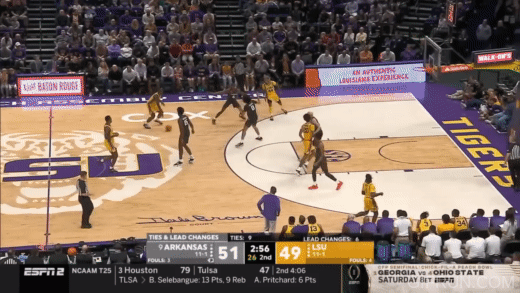
Hannibal isn’t a great shooter (44% EFG) and he turns it over like crazy (25% turnover rate), but he spends a ton of time at the free throw line (25% free throw usage), so if you can’t stay in front of him, he can cause some problems.
The final starter is Fountain, a Mississippi State transfer who grades as LSU’s best defender (100 DRAPM). Fountain isn’t actually an elite shot blocker like you might expect, but instead, he leads the Tigers in steal rate (4%) and total rebounding rate (14%), while his length supports the Tiger zone. On offense, he’s LSU’s best offensive rebounder (12%). He shoots well around the rim and can get to the line, but looks out of place when LSU tries to have him play out on the perimeter. He is a major turnover liability (23%).
Off the bench, we might see a little bit of 6’10 freshman Jalen Reed, a low-usage big who both fouls and draws fouls at a high rate.
When LSU has the ball

LSU won’t get much from their transition game, but their halfcourt offense isn’t terrible. Their pace is slightly slower than the Division I average.

LSU is mediocre at everything on offense. They are reasonably good at getting to the rim (99th in rim usage) and crashing the offensive boards (142nd). Williams and Fountain help by spacing the floor to create driving lanes for guards and then acting as rim-runners to finish on pick-and-rolls and clean up missed shots.
The biggest task for Arkansas remains defending without fouling. The Hogs briefly cracked the top 150 in opponent free throw rate a few weeks back, but they have now plummeted to 265th after the foul-fests against Alabama, Vanderbilt, and Mizzou. They were whistled for fewer fouls against Ole Miss, though Eric Musselman insists they did nothing different.
The other task will be cleaning up the defense against Hannibal. Devo will likely be responsible for Miller and shut him down last time (7 points on 9 field goal attempts), and it appears that Miller’s snarky threat about the return game in Fayetteville is now printed out and posted in Arkansas’ locker room, so I think we know who Devo’s responsibility will be.
But Hannibal ate Black up. Black has occasionally had some issues staying in front of quick guards, and that’s a problem against LSU because the Tigers will be trying to pull the center out from under the basket, so help there will be limited if you lose leverage on the perimeter.
The Hogs also finally cranked up the turnovers against Ole Miss. Does that continue? LSU’s main ballhandlers (Williams and Hill) do a good job of protecting the ball, but most of the supporting cast has serious turnover problems. Fountain, for instance, had 14 points and 10 rebounds (4 offensive) in the first meeting, with only two turnovers. His impact can be limited if the Hogs can force more turnovers against him.
When Arkansas has the ball

LSU’s defense is vulnerable in transition but tends to force longer halfcourt possessions. Their offense turning it over is the Achilles’ heel of their defense. Arkansas has really struggled to run in SEC play – and barely tried against Ole Miss – but if LSU does indeed play mostly zone, the Hogs have to beat it down the floor whenever possible and score before it can get set up. Otherwise, they will have to make some jump shots.

Lots of red and green for this matchup, which features strength-on-strength and weakness-on-weakness. Arkansas is good at getting to the rim, finishing there, and drawing fouls, while LSU is good at preventing shots near the rim and not fouling.
But LSU’s zone is going to force a lot of 3-point shots, and the Tigers do a nice job of closing out, so those shots aren’t always open. Instead, patient offenses that can actually get to the rim can finish there. Here are the field goal percentages at the rim for LSU’s opponents in SEC play:
- Arkansas: 63%
- Kentucky: 88% (!!!)
- Texas A&M: 91% (!!!)
- Florida: 72%
- Alabama: 74%
- Auburn: 52%
- Tennessee: 75%
Arkansas obviously missed the memo in the first meeting. LSU will only allow about 30-40% of shots to actually come at the rim, but the Hogs have to finish on better than 63%. If you can take advantage of those opportunities, you can win without hitting many 3-pointers.
In that first matchup, Arkansas had a lot of shots around the rim that normally go down miss. Council, in particular, struggled to get many of his shots to fall:
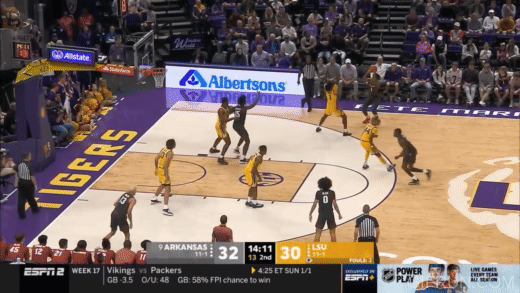
His game score of 4.5 in this game was his worst until the Ole Miss game. Check out his game scores by game this season:
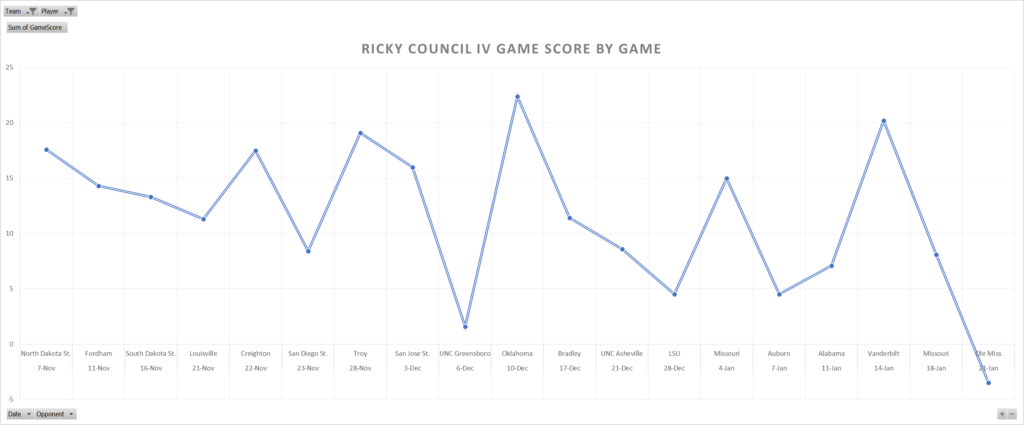
Until the Ole Miss game, his worst games are obvious: San Diego State, UNC Greensboro, LSU, Auburn, and Alabama. All of those teams are very good at keeping you away from the rim: SDSU and Greensboro are pack-line defenses, LSU and Auburn played zone, and Alabama plays a man-to-man that aims to prevent shots at the rim. Council’s strong performance in the first Missouri game was due to the second half, after the Tigers had abandoned their zone.
If Council struggles against LSU like he did in the first game, the Hogs need to go to Pinion. Arkansas is outscoring opponents 62-40 in SEC play in lineups where Pinion replaces Council, with almost all of those coming in the first Missouri game and against Ole Miss. Pinion is a better fit on the floor with other perimeter passers like Black, Devo, and Walsh (plus Makhi, who had an assist to Pinion against Ole Miss, is Arkansas’ best passing big). He’s obviously more of a defensive liability (Council actually grades as an excellent defender, even though he’s a poor rebounder), so his minutes may depend on his ability to be at least decent at that end of the floor.
Keys to the Game
- Finish at the rim. This is what got Arkansas beat in the first game. If they can finish their limited opportunities around the rim, the Hogs can win without elite perimeter shooting. But if Council is off, we’ll need to see more of a perimeter shooting threat to space LSU out more effectively.
- Stop the ball on the perimeter. LSU guard Trae Hannibal dribbled right past the Hogs in the first matchup. The Razorbacks need to stay in front and not get beat off the dribble.
- Defend without fouling. This has to be a key after what we’ve seen in SEC play so far. Walsh in particular must stay out of foul trouble in a game like this.
Thanks for reading! Be sure to follow us on Twitter and on Facebook.
The latest from Fayette Villains, straight to your inbox
Enter your email to subscribe and receive new post alerts and other updates. You can unsubscribe at any time.
